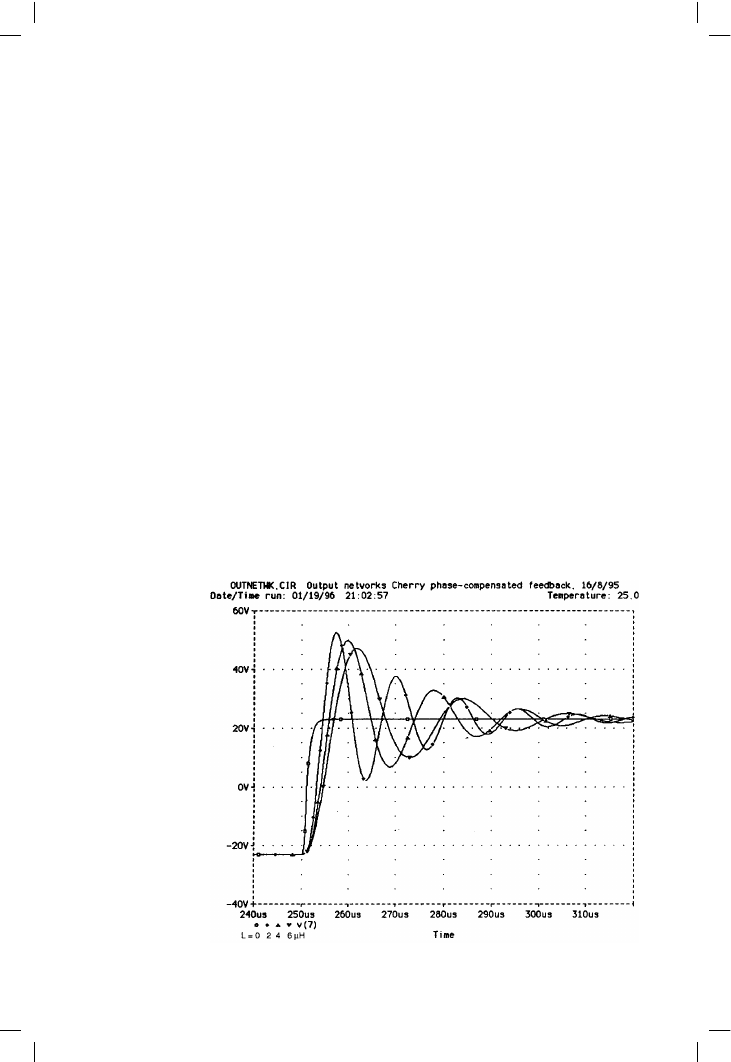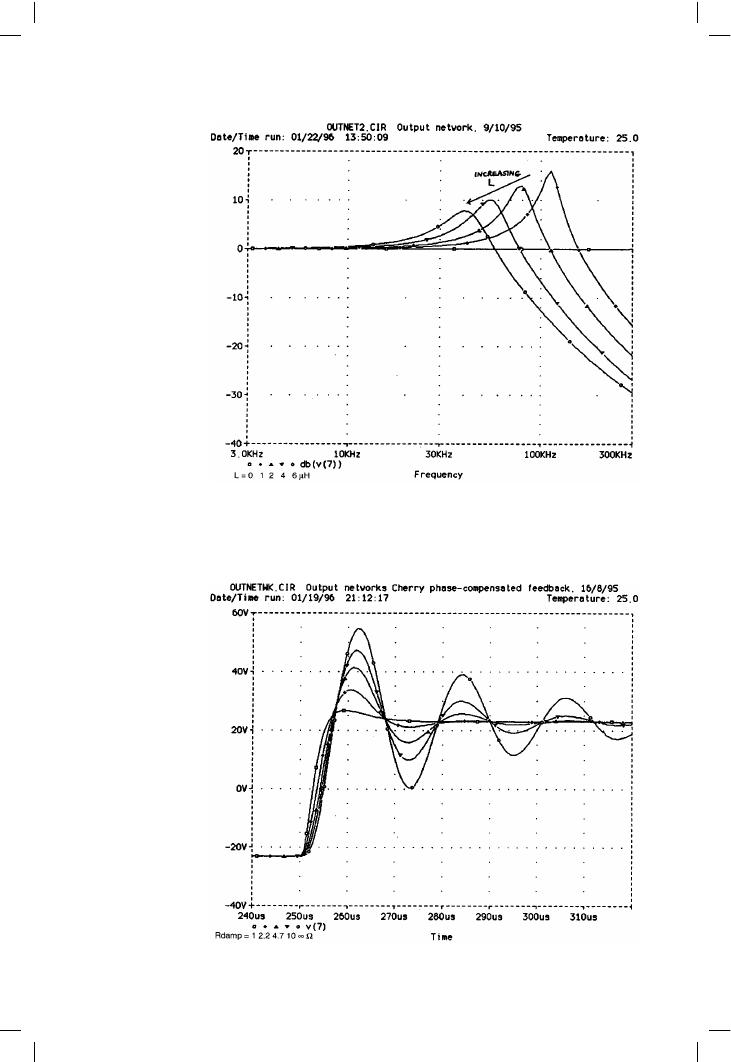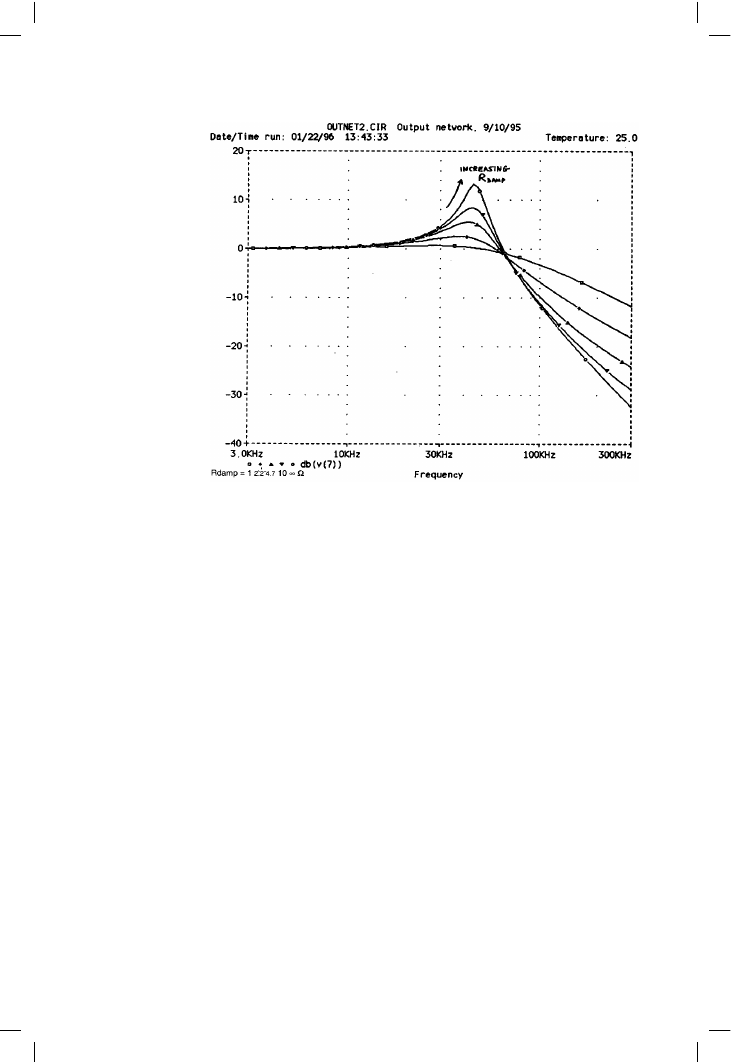ВУЗ: Казахская Национальная Академия Искусств им. Т. Жургенова
Категория: Учебное пособие
Дисциплина: Не указана
Добавлен: 03.02.2019
Просмотров: 17426
Скачиваний: 18

Compensation, slew-rate, and stability
see why a capacitative load on an amplifier with a finite output resistance
could cause HF instability by introducing extra lagging phase-shift into the
global NFB loop, but it is less clear why an inductive load should be a
problem; if a capacitive load reduces stability margins, then it seems
reasonable that an inductive one would increase them.
At this point I felt some experiments were called for, and so I removed the
standard 10 !/0.1 µF Zobel from a Blameless Class-B amplifier with CFP
output and the usual NFB factor of 32 dB at 20 kHz. With an 8 ! resistive
load the THD performance and stability were unchanged. However, when
a 0.47 mH inductor was added in series, to roughly simulate a single-unit
loudspeaker, there was evidence of local VHF instability in the output
stage; there was certainly no Nyquist instability of the global NFB loop.
I also attempted to reduce the loading placed on the output by the Zobel
network. However, increasing the series resistance to 22 ! still gave some
evidence of stability problems, and I was forced to the depressing
conclusion that the standard values are just about right. In fact, with the
standard 10 !/0.1 µF network the extra loading placed on the amplifier at
HF is not great; for a 1 V output at 10 kHz the Zobel network draws 6.3 mA,
rising to 12.4 mA at 20 kHz, compared with 125 mA drawn at all
frequencies by an 8 ! resistor. These currents can be simply scaled up for
realistic output levels, and this allows the Zobel resistor power rating to be
determined. Thus an amplifier capable of 20 Vrms output must have a
Zobel resistor capable of sustaining 248 mA rms at 20 kHz, dissipating
0.62 W; a 1 W component could be chosen.
In fact, the greatest stress is placed on the Zobel resistor by HF instability, as
amplifier oscillation is often in the range 50–500 kHz. It should therefore be
chosen to withstand this for at least a short time, as otherwise faultfinding
becomes rather fraught; ratings in the range 3 to 5 W are usual.
To conclude this section, there seems no doubt that a Zobel network is
required with any load that is even mildly inductive. The resistor can be of
an ordinary wire-wound type, rated to 5 W or more; this should prevent its
burn-out under HF instability. A wire-wound resistor may reduce the
effectiveness of the Zobel at VHF, but seems to work well in practice; the
Zobel still gives effective stabilisation with inductive loads.
195
Output inductors
Only in the simplest kinds of power amplifier is it usual for the output stage
to be connected directly to the external load. Direct connection is generally
only feasible for amplifiers with low feedback factors, which have large
safety margins against Nyquist instability caused by reactive loads.
For many years designers have been wary of what may happen when a
capacitive load is connected to their amplifiers; a fear that dates back to the

Audio Power Amplifier Design Handbook
introduction of the first practical electrostatic loudspeaker from Quad
Acoustics, which was crudely emulated by adding a 2 µF capacitor in
parallel to the usual 8 ! resistive test load. The real load impedance
presented by an electrostatic speaker is far more complex than this, largely
as a result of the step-up transformer required to develop the appropriate
drive voltages, but a 2 µF capacitor alone can cause instability in an
amplifier unless precautions are taken.
When a shunt capacitor is placed across a resistive load in this way, and no
output inductor is fitted, it is usually found that the value with the most
destabilising effect is nearer 100 nF than 2 µF.
The most effective precaution against this form of instability is a small air-
cored inductor in series with the amplifier output. This isolates the amplifier
from the shunt capacitance, without causing significant losses at audio
frequencies. The value is normally in the region 1–7 µH, the upper limit
being set by the need to avoid significant HF roll-off into a 4 ! load. If 2 !
loads are contemplated then this limit must be halved.
It is usual to test amplifier transient response with a square-wave while the
output is loaded with 8 ! and 2 µF in parallel to simulate an electrostatic
loudspeaker, as this is often regarded as the most demanding condition.
However, there is an inductor in the amplifier output, and when there is
significant capacitance in the load they resonate together, giving a peak in
the frequency response at the HF end, and overshoot and ringing on fast
edges.
This test therefore does not actually examine amplifier response at all, for
the damped ringing that is almost universally seen during these capacitive
loading tests is due to the output inductor resonating with the test load
capacitance, and has nothing whatever to do with amplifier stability. The
ringing is usually around 40 kHz or so, and this is much too slow to be
blamed on any normally compensated amplifier. The output network adds
ringing to the transient response even if the amplifier itself is perfect.
It is good practice to put a low-value damping resistor across the inductor;
this reduces the Q of the output LC combination on capacitive loading, and
thus reduces overshoot and ringing.
If a power amplifier is deliberately provoked by shorting out the output
inductor and applying a capacitive load, then the oscillation is usually
around 100–500 kHz, and can be destructive of the output transistors if
allowed to persist. It is nothing like the neat ringing seen in typical
capacitive load tests. In this case there is no such thing as nicely damped
ringing because damped oscillation at 500 kHz probably means you are
one bare step away from oscillatory disaster.
Attempts to test this on the circuit of Figure 7.5 were frustrated because it
is actually rather resistant to capacitance-induced oscillation, probably
196

Compensation, slew-rate, and stability
because the level of global feedback is fairly modest. 100 nF directly across
the output induced damped ringing at 420 kHz, while 470 nF gave ringing
at 300 kHz, and 2 µF at 125 kHz.
While the 8 !/2 µF test described above actually reveals nothing about
amplifier transient response, it is embedded in tradition, and it is too
optimistic to expect its doubtful nature to be universally recognised.
Minimising output ringing is of some commercial importance; several
factors affect it, and can be manipulated to tidy up the overshoot and avoid
deterring potential customers:
!
The output inductance value. Increasing the inductance with all other
components held constant reduces the overshoot and the amount of
response peaking, but the peak moves downward in frequency so the
rising response begins to invade the audio band. See Figures 7.8, 7.9.
!
The value of the damping resistor across the output coil. Reducing its
value reduces the Q of the output LC tuned circuit, and so reduces
overshoot and ringing. The resistor is usually 10 !, and can be a
conventional wirewound type without problems due to self-inductance;
10 ! reduces the overshoot from 58% without damping to 48%, and
much reduces ringing. Response peaking is reduced with only a slight
effect on frequency. See Figures 7.10, 7.11. The damping resistor can in
fact be reduced as to low as 1 !, providing the amplifier stability into
capacitance remains dependable, and this reduces the transient over-
shoot further from 48% to 19%, and eliminates ringing altogether; there
197
Figure 7.8
Transient response
with varying output
inductance;
increasing L reduces
ringing frequency,
without much effect
on overshoot. Input
risetime 1 µsec

Audio Power Amplifier Design Handbook
198
Figure 7.9
Increasing the output
inductance reduces
frequency response
peaking and lowers
its frequency
Figure 7.10
The effect of varying
the damping
resistance on
transient response.
1 ! almost eliminates
overshoot

Compensation, slew-rate, and stability
is just a single overshoot. Whether this is more visually appealing to the
potential customer is an interesting point.
!
The load capacitance value. Increasing this with the shunt resistor held
at 8 ! gives more overshoot and lower frequency ringing that decays
more slowly. The response peaking is both sharper and lower in
frequency, which is not a good combination. However, this component
is part of the standard test load and is outside the designer’s control. See
Figures 7.12, 7.13.
!
In actual fact, by far the most important factor affecting overshoot and
ringing is the rise-time of the applied square wave. This is yet another
rather important audio fact that seems to be almost unknown. Figure
7.14 shows how the overshoot given by the circuit in Figure 7.6 is 51%
for a 1 µsec rise-time, but only 12% for a 20 µsec rise-time. It is clear that
the transient response measured in this test may depend critically on the
details of the testgear and the amplifier slew-rate, and can be
manipulated to give the result you want.
An output inductor should be air-cored to eliminate the possibility of extra
distortion due to the saturation of magnetic materials. Ferrite-based VHF
chokes give stable operation, but their linearity must be considered
dubious. In the 1970s there was a fashion for using one of the big power-
supply electrolytics as a coil-former, but this is not a good idea. The
magnetic characteristics of the capacitor are unknown, and its lifetime may
be reduced by the heat dissipated in the coil winding resistance.
199
Figure 7.11
The effect of varying
damping resistance
on frequency
response. Lower
values reduce the
peaking around
40 kHz